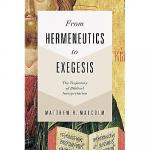Bryan D Estelle
Echoes of Exodus: Tracing a Biblical Motif.
Downers Grove, IL: IVP Academic, 2018.
Available at IVP
By Andrew Judd (Lecturer in Old Testament, Ridley College)
Echoes of Exodus shows how the exodus event develops as a persistent literary motif throughout the canon of scripture. The indefinite article in the subtitle is important. Bryan Estelle has taken to heart James Barr’s warning that setting out to distil the theology of the whole Bible is a ridiculous undertaking, and so his goal is more modest: to trace one significant theme from beginning to end, arguing that the exodus ultimately becomes synecdoche for salvation in general.
This kind of biblical theology of the exodus stands firmly within the tradition of the biblical theology of Geerhardus Vos. What’s new is the fresh attention he gives to the underlying hermeneutical questions raised by such a study. His exegetical chapters are sandwiched between two discussions about intertextuality (chapter 1 and an orphaned appendix). These present a useful introduction to some of the issues you might talk about in an introductory hermeneutics class: pre-critical exegesis, responsible typology versus allegory, and what we can learn from structuralism. These are helpful orientations, although given the limited space, I found a tension at times between Estelle’s goal of explaining these ideas to students, on the one hand, and his project of establishing his own framework in response to them.
The study proper kicks off with Genesis in chapter 2. In solid Presbyterian style Estelle seeks to anchor the covenantal exodus motif to creation. We meet the exodus motif proper in chapter 3, with a particular focus on the Song of the Sea (Exod 15), which is then taken up in a discussion of some key exodus-related Psalms in chapter 4. The motif takes a turn towards the New Covenant in Isaiah (chapter 5), before being further reconfigured in the second exodus experience of the return from exile (chapter 6). This brings us into New Testament land; Mark and Matthew show the polity ramifications of the new Sinai experience in (chapter 7); Luke-Acts show how the Isaianic new exodus is fulfilled in the taking of the gospel to gentiles. We skip John’s gospel and find a number of strands come together in Paul (chapter 8, where Estelle argues for the importance of the exodus for understanding language of adoption), Peter (chapter 9, where Christian identity is constructed around an ‘ecclesial’ reading of the exodus motif) and Revelation (chapter 10, where the new exodus is consummated by the passover Lamb of God).
Aside from demonstrating how pervasive this motif is, this study serves to bring out connections between ideas that might otherwise be soft-pedalled. In this grand scene, the exodus becomes about more than simply liberation from generic oppression. The exodus motif becomes one long story about justification by faith. The entitlement-to-the-world-to-come which Adam lost is regained through God’s offer of exodus, the bringing of God’s people to a place where they enjoy the ethical righteousness and perfected worship God always intended for them: first at Sinai, then in Canaan, and finally in the world-to-come. As Estelle (like Vos) tells the story, eschatology precedes soteriology. Estelle gently suggests that this might be something of a circuit breaker in the intractable debates over between juridical and participationist gangs.
Any biblical theology is a brave undertaking, even when it is suitably chastened in its goals by Barr’s stern warnings. Big picture studies must contend with the constant suspicion of reductionism, the nagging ghosts of German critics, and the professional structures of infinitesimal specialization. Big scope makes for a big target. And yet there is something vitally refreshing about taking a step back to admire the whole artwork of the Bible through a single lens. This is an important and largely successful project, demonstrating how Israel’s exodus from Egypt operates as a consistent, though evolving, literary motif throughout Old and New Testaments. I commend this book as a great resource for seminary students and teachers.
(PS: This book is not to be confused with another Echoes of Exodus, subtitled Tracing Tracing Themes of Redemption through Scripture, by Alastair Roberts and Andrew Wilson and published by Crossway. For marketing purposes I imagine it is not ideal to have two books on the same theme, released in the same year, with the same title — apparently, the alliteration proved too alluring to avoid. Happily, though, the books are for different audiences: at easily double the page count, Estelle’s book is aimed more at postgraduate students than your everyday reader.)












